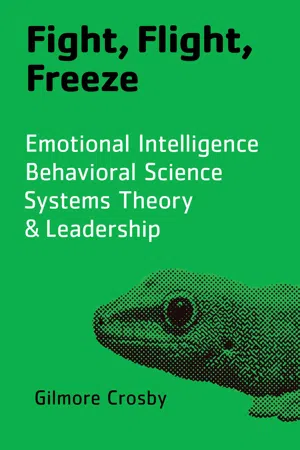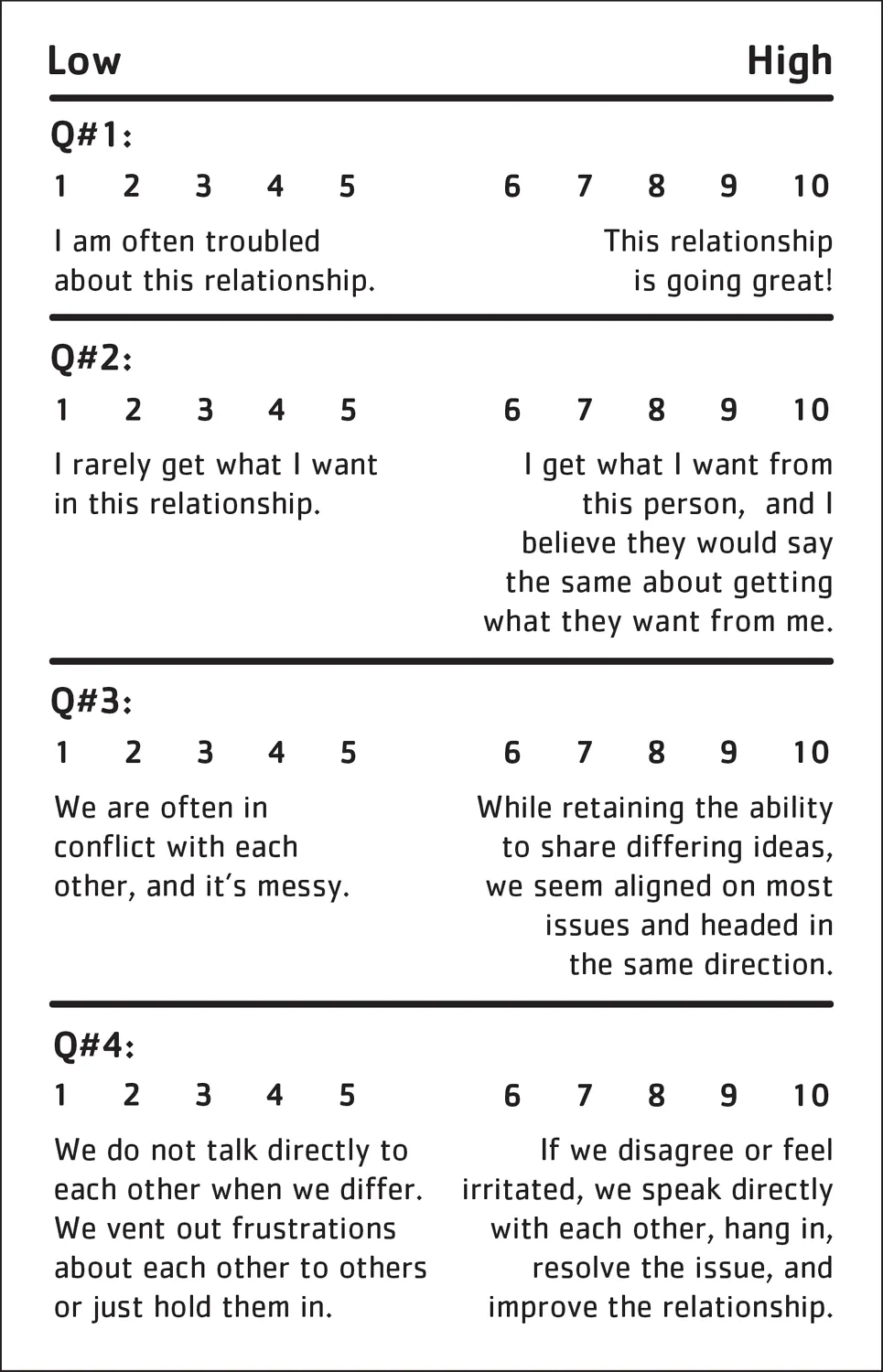
eBook - ePub
Fight, Flight, Freeze
Emotional Intelligence, Behavioral Science, Systems Theory & Leadership
This is a test
- English
- ePUB (mobile friendly)
- Available on iOS & Android
eBook - ePub
Fight, Flight, Freeze
Emotional Intelligence, Behavioral Science, Systems Theory & Leadership
Book details
Book preview
Table of contents
Citations
About This Book
You can be more effective in your relationships at home and at work...a better friend, spouse, parent, employee and/or boss. The unique and understandable mix of brain research and behavioral science in Fight, Flight, Freeze is a proven recipe for unleashing your interpersonal potential. Let author Gilmore Crosby guide you on a journey of self-improvement certain to have quick and lasting results!
Frequently asked questions
At the moment all of our mobile-responsive ePub books are available to download via the app. Most of our PDFs are also available to download and we're working on making the final remaining ones downloadable now. Learn more here.
Both plans give you full access to the library and all of Perlego’s features. The only differences are the price and subscription period: With the annual plan you’ll save around 30% compared to 12 months on the monthly plan.
We are an online textbook subscription service, where you can get access to an entire online library for less than the price of a single book per month. With over 1 million books across 1000+ topics, we’ve got you covered! Learn more here.
Look out for the read-aloud symbol on your next book to see if you can listen to it. The read-aloud tool reads text aloud for you, highlighting the text as it is being read. You can pause it, speed it up and slow it down. Learn more here.
Yes, you can access Fight, Flight, Freeze by Gilmore Crosby in PDF and/or ePUB format, as well as other popular books in Personal Development & Self Improvement. We have over one million books available in our catalogue for you to explore.
Information
Chapter 1
Beginning the Journey

What has to happen to improve your relationships at home and at work?
What do you think has to happen? Read the quiz on the next page, and then rate your relationships at home, work, or both.
Is it hard to decide where to focus? Many people tell me they are very different at home and at work. Of course, there is truth to this, but the key to learning about yourself and creating what you want lies in being able to learn from any of your experiences. To gain the most from this book, focus on whichever situation you want, either at home or at work, and look for the common patterns in your reactions and behavior. The trick is to be able to learn in the midst of any important relationship. Pick one, and rate it. You can always focus on additional relationships later, as you proceed through this book.
To do the rating, pick a number from 1 to 10, with 1 representing a low score, or the worst possible condition, and 10 representing the best possible condition. You could pick any number on the scale (a 3 would be not good but not terrible, a 6 would be slightly better than average, etc.):
Figure 1: Relationship Quiz

Now, reflect on the rating that seems most important to you. Describe what is happening in the relationship that leads you to that rating. What would it take for you to give that question a higher rating? Write about what it would take (some people like to write, some do not. While many of the writing assignments in this guide are optional for learning, in this case writing greatly increases the likelihood that you gain what is intended from this exercise, so please write before proceeding further):
Now look at your writing. The language you use reflects your tendencies when it comes to thinking about challenging relationships. Most people are better at critiquing the behavior of others than they are at critiquing themselves. In fact, they are so good at criticizing others that they often have no clue about their own role in whatever is going wrong, and actually believe that the only way for things to improve is if the other person somehow changes. What’s worse, the behavior of focusing on the other is unlikely to be welcomed, thus further fueling tension in the relationship. The other is likely to respond in kind, focusing their energy on what’s wrong with you. By focusing primarily on how the other could be different, one is essentially saying “this relationship will only be better if you are better.” The key to change is placed outside the self. This focus on the other, which creates a “victim” mentality, pervades modern culture. Allow me to explain.
But first ponder this…a critical skill in adult learning is the capacity for reasonably objective self-critique. This book will offer various means for doing so, as well as tips for getting feedback from others. If you are not willing to study yourself, then this book is not for you.
Using the following chart, look at what you wrote about “what it would take to give a higher rating” (or think about what you thought, if you didn’t do the writing), and critique your language. Were you thinking about what you could do differently, or about what others could (or should) do? Were you using “I” language, or other focused language? Were you thinking as a victim or as a creator?
Figure 2: Victim/Creator Model

Before I say more about the difference between a “victim” and a “creator,” take a moment to notice your emotions as you are reacting to this self-assessment. Emotion plays a powerful role in influencing your thoughts, and it’s vital to your development that you recognize your emotional states as clearly as you can. Name your current emotion, if you can. Is your emotional state helping or is it hampering your ability to learn?
If you are explaining to yourself why you used “victim” language, and why it’s justified to do so, then you are probably experiencing the emotional state of defensiveness. If this is true and you can see it and admit it, congratulations! You have the capacity to learn about defensiveness, a normal human reaction, and influence the amount of time and energy you allow that emotion to sway your thoughts and behaviors. If you are feeling defensive and don’t know it (a paradox, but quite possible), then it’s much more likely to be a repetitive experience that interferes with relationships and learning. The clearest indications of this emotional state are behavioral - for example, the behavior of explaining yourself to yourself (in your head, or possibly even out loud) and/or to others. Whenever you begin explaining yourself, it’s a safe bet that you’re acting on the emotion of defensiveness.
Whatever your current emotion, by paying attention to your emotional reaction to the above exercise, we have begun scratching the surface of the critical role that emotional awareness plays in self-awareness, self-development, and relationships. To learn about yourself, it will be vital to explore your beliefs about emotions. You probably think that some, such as love, are good, and that some, such as defensiveness, are bad. Such beliefs can prevent us from seeing clearly what emotions we, and others, are experiencing. From the perspective of this guidebook, emotion is not inherently good or bad; emotion is simply a constant part of being human. The question is what we do with emotion. If we are unaware of our emotions, we have less control over their impact on our thoughts and behaviors. When we are aware, regardless of what type of emotion is present, we have more influence over what we think and do.
We will continue to explore emotion in just a bit. For now, return to the language you used when you pondered what it would take to give that question a higher rating. If you used “I” language, you were almost certainly focused on what you could do differently. This is the essence of the difference between being in victim or creator mode. As a creator, you are taking responsibility for your influence on relationships at home and at work. Your task is to understand your own part in what is going well, and what is not going well, and to make adjustments by trying on new behaviors and perspectives. This workbook will open your eyes to many possible choices.
Be careful not to fall into the trap of fooling yourself when looking at the language you used. In creator mode, “I” language indicates speaking for yourself, and taking responsibility for what needs to happen. But one can use the word “I” and remain in victim mode, as in the following examples: “I think my husband should listen more.” “I think if management were more trustworthy, things would be better around here.” These might be reasonable things to want, but you have only shifted out of victim mode if you are looking at your own role in what is happening, and thinking about what you are going to do about it.
Your clarity about the line between victim and creator can also be blurred by the word “we.” There are, of course, times when it is accurate and in good taste to use the word we, as in “we’re all in this together,” and when giving credit to a group when group credit is due (“We got it done”). At other times, people use “we” in more slippery ways. “We” is used as protection, or to lend weight to an argument, as in “Boss, we all think…” or to claim there’s agreement when there really is not (“We decided…”).
During the exercise, if you said something like, “things will be better when we all start doing our part,” you were still primarily in victim mode. Waiting for “everyone” to change takes the responsibility off of you, even though you are part of the “we.” Figuring out what you’re going to do to start the change, puts you back in creator mode.
To be a true “we,” a group has to be made up of individuals who think and speak for themselves, and respect that in each other. To be a true “we,” the group has to be made up of individuals who operate most of the time in creator mode. Otherwise “we” is often wishful thinking, based on fear. People pretend to agree even when they don’t. There is a show of unity, but real differences are shied away from, and the unity is fragile. By developing yourself and being a creator more of the time, you will also be a healthier influence on the groups you belong to, both at work and in your personal life, including your family.
We all spend some time in victim mode. When there, it is easy to blame others and circumstances for reactions and conditions you don’t like. As mentioned above, it is also easy to fool yourself into thinking you are taking responsibility, even when you are not. Perhaps you are “being proactive” by looking for the “right” mate or job (efforts which deserve respect), but such solutions still imply that the answer to your problems lies outside of yourself. If only you could get lucky and find the right circumstances. If only your boss/spouse/co-workers/income/president was this way or that; then you would be happy.
Victor Frankl, the author of Man’s Search for Meaning, found the “right circumstances” as a prisoner in a Nazi concentration camp. He was able to find hope and pleasure in relationships, however fleeting, and in the beauty of a sunset, while other prisoners withered away. According to Frankl, “Everything can be taken from a man but…the last of the human freedoms - to choose one’s attitude in any given set of circumstances, to choose one’s own way.” If he could be in creator mode, under the most horrible of circumstances, then you and I have no excuse.
Whatever your circumstances, you create your experience. You are limiting yourself in some way (we all do). You are capable of more than you currently imagine. You are already a creator, regardless of how you answered the “I” language quiz. You created the ability to walk and to talk, for example, without skipping a beat. Admittedly, you were unencumbered at the time by fear of failure, but fear can be overcome. With this workbook, you can create new ways to think, feel, relate, get results, and learn about yourself on an ongoing basis.
Although potentially painful at times, critiquing yourself is much more empowering than being focused on critiquing everyone else. The critical skill in self-development is whether you are willing to look at yourself rather than look outside yourself when dealing with difficulty. If you used “victim” language in the exercise above, you were thinking at that moment as if you are powerless to alter what is happening, unless other people change. In other words, your vision was limited to the change that could occur in them, something you have very little control over. The people around you will only change if they chose to start with themselves. Your best bet to create more of what you want, regardless of their choices, is to do the same. Don’t wait for them to be different. Start with yourself.
If you didn’t use “I” language during this exercise, that doesn’t mean that you always focus on what others need to do differently, instead of starting with yourself, but it at least means that it’s enough of a habit that you slipped into it during this activity. If so, don’t beat yourself up. Even the most emotionally mature humans slip into victim thinking at times. Your mission, if you choose to accept it, is to become more aware of the difference between being in victim or creator mode, and to choose creator mode as often as possible.
Victim thinking, if you slipped into it, is the first barrier to creating what you want. Rewrite what it would take for you to give that question a higher rating, using “I” language. Notice the difference that comes from shifting your focus.
If you used “I” language in the exercise, congratulations, you already have the habit, at times of starting with yourself (as, no doubt, do those who used victim language). Keep it up. Increase the habit! And read on. The journey has only begun.
Chapter 2
Emotional Intelligence:
Taming the Reptilian Brain
Taming the Reptilian Brain

One of the dilemmas of being human, with consequences at work and in our personal lives, is the fabulous instinctual behavior that protects us from physical dangers - the instincts of fight, flight, and freeze. These reaction...
Table of contents
- Front Cover
- Title Page
- Copyright Page
- Table of Contents
- Acknowledgments
- Introduction
- Chapter 1: Beginning the Journey
- Chapter 2: Emotional Intelligence
- Chapter 3: Behavioral Science
- Chapter 4: Four Key Skills
- Chapter 5: Self-Awareness
- Chapter 6: Dialogue and Discussion
- Chapter 7: Dances of Virginia Satir
- Chapter 8: Triangulation
- Chapter 9: Conflict
- Chapter 10: Systems Theory
- Chapter 11: Application to Work
- Chapter 12: Self-Differentiated Leadership
- Bibliography